THE TRIP TO THE ROMAN FORUM
Part Three: ROME
REBORN
Written by Rick Archer
January, 2010
My trip to the
Roman Forum was disappointing on so many levels.
More than anything else I was crushed to discover so many magnificent
buildings had been practically leveled.
In addition,
without a guide, an audiotape, or even a decent guidebook,
all day long I started blankly at abandoned rocks I was
certain had history written all over them. I
was incredibly angry at myself for basically wasting the
chance of a lifetime to learn more about the Roman Empire, a
period of history I have been fascinated with ever since I
was a little boy.
My disappointment at grasping very little of what I saw during my
trip to the Forum was so intense that I vowed I would do my
homework when I got back to Houston.
As I poked my
nose around the Internet plus the two books on ancient Rome I bought
as an afterthought , I was
delighted to find there were a lot of people who felt the
same way about wondering what ancient Rome had really looked
like... and had done something about it!
Rome was first recreated as a model back in the mid-Twentieth Century.
A plaster representation known as Plastico di Roma
Antica was created from 1933 to 1971 complete with
aqueducts and restored temples to the Roman Gods. At the time,
it was considered a modern marvel in its own right.
After all, it took archeologists and model makers forty
years to complete this task! They say Rome wasn't
built in a day. Now we had was living proof even the
model of Rome took forty years.
This project was the brain child of Italian dictator Benito
Mussolini. To commemorate the birth of Augustus (63 BC) two
thousand years earlier, Mussolini decided to commission a
model of Rome as it appeared at the time of Constantine (AD
306-337), when the city had reached its greatest size.
Fortunately, he knew just who to ask to help him complete
his vision.
|
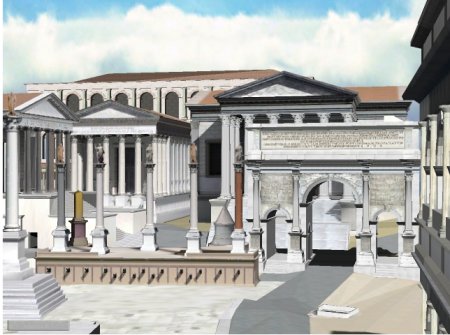
The Roman Forum of Yesterday
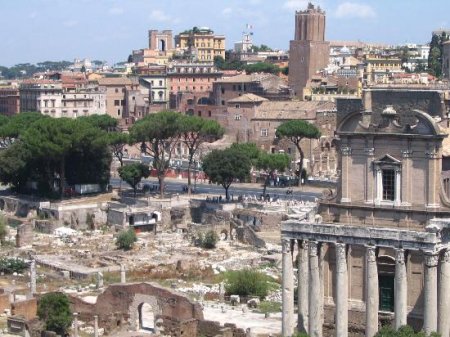
The Roman Forum of
Today
|
Italo Gismondi
was
trained as an architect; however he was better known as a leading
archaeologist. Entering the Italian culture ministry, he was named
director of the excavations at Ostia (the ancient port of Rome), a post that he held for over
40 years.
Gismondi's architectural background enabled him to make a detailed
study of ancient building practices and design. There weren't
too many archeologists who were also architects. Gismondi
discovered he was one of the few who could figure out what a
building looked like based on a limited set of clues.
With practice, Gismondi developed a knack for recreating what buildings
had looked like out of fragmentary remains. One of his legacies
was putting together the first detailed map of the monuments of
the Roman Forum, published in 1933, complete with drawings of what
the buildings had probably looked like.
|
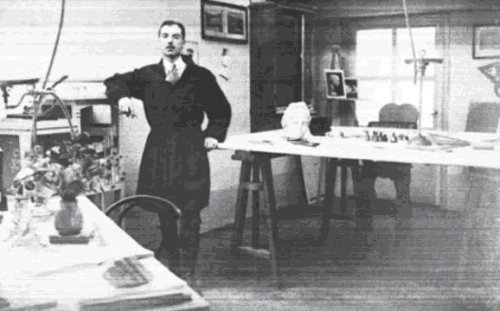 |
|
Plastico di Roma
Antica
Gismondi's excellent
map of the ancient Forum is what brought him to Mussolini's
attention. Mussolini had received much criticism for
destroying a valuable section of the Roman Forum to put in a
highway. Now Mussolini had an idea how he could turn some of that
wrath into renewed civic pride.
Trying to make
amends for bulldozing valuable ruins to make way for his
Imperial Highway (including the Forum of Caesar
no less) , Mussolini turned to Gismondi and proposed a
model of ancient Rome on a giant scale.
Gismondi smiled. To him, all his previous experiences
had uniquely prepared him for a project of the magnitude.
He was willing to give it his best effort.
From 1933-1937 Gismondi worked
furiously to prepare the model for a world's fair in Rome.
The
model received so much praise that Gismondi was encouraged
to extend the model further. He spent forty years completing
his work, finishing in 1971 just three years before his
death.
Today
the plastic model can be viewed in the city's Museum
of Roman Civilization. The model is built to 1:240
scale. It extends more than fifty-five feet across!
This huge picture captures just one little corner of the
structure, but gives a hint at how large it really is. As you can guess,
when seen in person, this 20 meter by 20 meter model
is a massive piece of construction. It takes up 4,500
square feet of space!
I
wonder how people are able to view the center. Maybe
people walk across it! (just kidding). Ah...
just found the answer... there is an elevated platform for
people to use.
It turns out the artists had to work with platforms as well
that were suspended just inches above the work space.
I wish I had a picture of that!
|
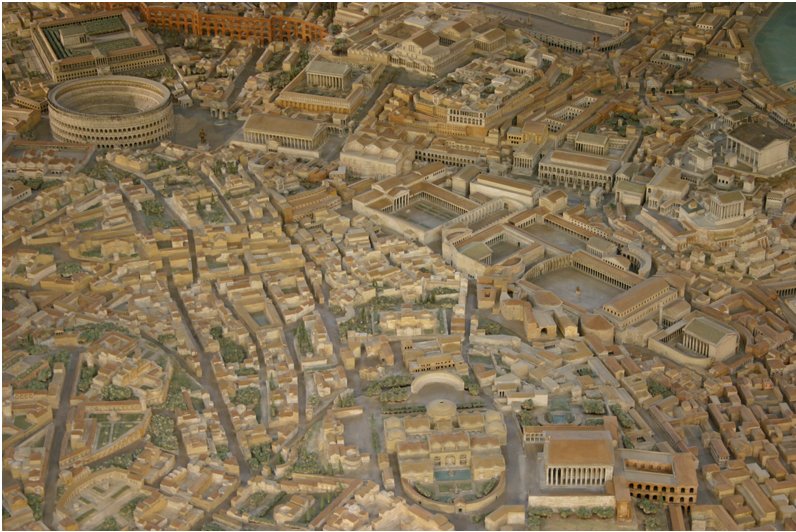 |
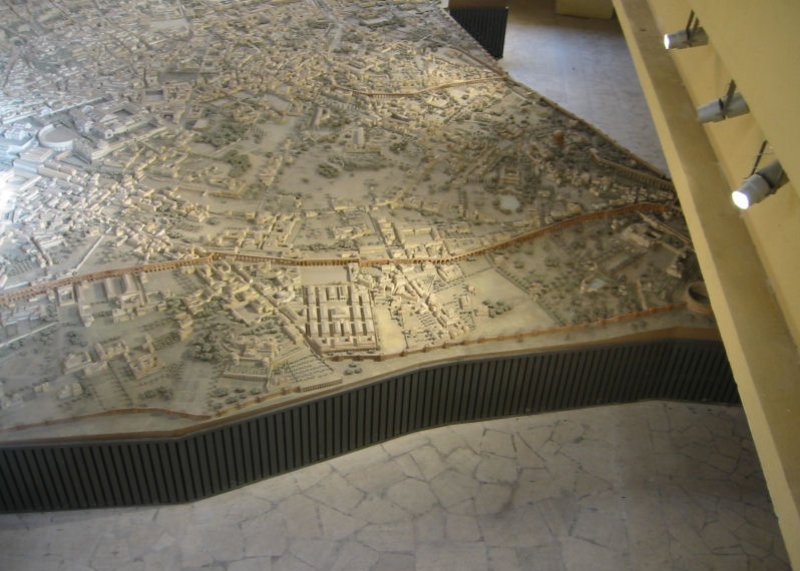 |
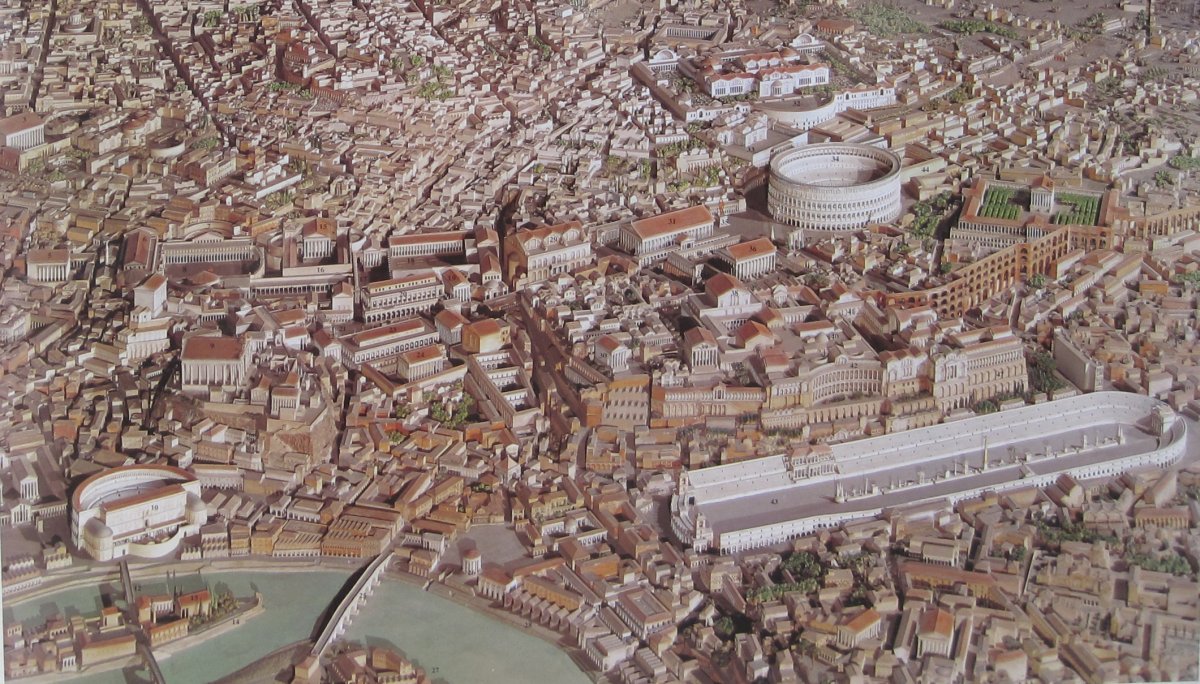
Another look
at a segment of the Plastico
di Roma Antica, Gismondi's Model of Ancient Rome.
The actual model is 55 by 55 feet.
Imagine this kind of detail spread out over 55 feet.
No wonder it took 40 years to finish!
|
ROME REBORN
A quote from
Johann Wolfgang Goethe expresses what most of us would say
after having to fend for himself in Rome without much in the
way of guide books. Upon first arriving in Rome, Goethe
wrote this in his diary:
"Rome is
something that has suffered many drastic changes in the
course of two thousand years, yet we find there still
the same soil, the same hill, often even the same column
or wall, and in its people one still finds traces of
their ancient character.
Contemplating this, the observer finds…it difficult…to
follow the evolution of the city, to grasp not only how
Modern Rome follows on Ancient, but also how, within
both, one age follows upon another.
I shall first of all try to grope my way along this
half-hidden track by myself, for only after I have done
that shall I be able to benefit from the excellent
earlier studies to which, from the fifteen century until
today, eminent scholars and artists have devoted their
lives."
Italo
Gismondi's amazing life project inspired many people during
the Twentieth Century. Among those people was a man
named Bernard Frischer. Frischer first
encountered the massive model of ancient Rome back in the
Seventies while studying at the American Academy in Rome.
He was immediately taken with it.
At the same
time, Frischer took note that Gismondi's Plastico was fixed
to a very remote museum in a suburb of Rome. Frischer
understood that educators couldn't readily take students or
tourists there, unless they were already in Rome. Even
then, finding this spot off the beaten path was a project in
itself. Frischer understood that the Rome model, as
wonderful as it was, didn't do much good hidden away (the
museum is located four miles south of the Colosseum.
It is way off the usual tourist trails).
“I grew up in
a family that had humanists in it,” says Frischer, “but we
had engineers among us as well. When I saw
the Plastico model, one side of me said, 'hey, this is
great!' At the same time, I thought to myself, ‘Wow,
nobody is going to see it here. We've got to use technology to get this wonderful model out
of this small room and bring it out where the entire world can
see it!' ”
Frischer
received his B.A. in Classics from Wesleyan University in
Connecticut in 1971 and his Ph.D. in Classics from
Germany's University of Heidelberg in 1975. Frischer
taught Classics at UCLA from 1976 to 2004. Since then
he became the Professor of Art History and Classics at the
University of Virginia, where from 2004-09 he also served as
Director of the Institute for Advanced Technology in the
Humanities. As of 2010, Frischer is currently Director
of the Virtual World Heritage Laboratory.
As he climbed
the academic ladder, Frischer never allowed his experience
of the Rome model to drift too far away out of his memory.
From the 1970s onward, Bernard Frischer experimented with
different technologies in his quest to simulate the ancient
city of Rome. While a fellow at the American Academy in Rome
in 1975, Frischer met urban designer Donald Appleyard of the
University of California, Berkeley.
Appleyard had developed a system of video editing that
presented models of new architectural projects within the
context of the surrounding neighborhood and city. Appleyard
died in 1982, but his work lived on through Fischer.
Appleyard had inspired Frischer to somehow find a way to
translate Gismondi's plaster-of-paris model of ancient Rome
into video form.
From 1978 to 1980, a research team from the Massachusetts
Institute of Technology created the Aspen Movie Map, a
navigable, touch screen tour of Aspen, Colorado, that was a
breakthrough in interactive media. The team mounted four
16mm film cameras on top of a car and drove down the center
of every street in Aspen, capturing front, back, and side
views. The scenes were transferred to laserdisc and linked
to a street plan of Aspen.
Fischer was fascinated with the work. “My idea was to
use the same approach, with miniature cameras going up and
down the streets of the [Rome] model,” says Frischer. So he
did some test shots of the plaster model of Rome to see if
it would support a close-up view. Unfortunately it didn't
work. “Eighty percent of the surfaces of buildings in that
model have no detail at all,” Frischer says. “So the idea of
a videodisc didn't fly. But the vision of simulating ancient
Rome stuck with me.”
From 1996 to 2004, Frischer was the founding director of the
UCLA Cultural Virtual Reality Laboratory. The lab was
one of the first in the world to use 3D computer modeling to
reconstruct cultural heritage sites. Thanks to his
association with the talented professionals at the
laboratory plus advances in computer technology, in 1996 Frischer was finally in position to begin his project in
earnest. He was excited to see if he could bring his
three-decade dream of recreating Rome to fruition.
Fortunately the advent of 3-D modeling software proved more
auspicious than the Aspen/Rome project of the Eighties.
The primary source for the model of Rome turned out to be
none other than Gismondi's “Plastico di Roma Antica”.
Some 7,000 buildings were scanned and reproduced using the
plastic model of the city.
Thanks to an
international team of architects, archaeologists and experts
that spent 10 years of hard work, the effort was successful.
Ancient Rome was been brought back to life through a unique
digital reconstruction project, said to be the world's
biggest computer simulation. Soon the mysteries of
what the structures looked like before their dilapidation
would be unveiled to an entire world audience.
In June, 2007,
at a public ceremony in Rome, scholars from three
institutions—the University of Virginia; the
University of
California, Los Angeles; and the Politecnico di
Milano—presented the results of the 10-year collaboration:
they had completed a
3-D computer model of ancient Rome titled Rome Reborn
1.0.
The project amazed spectators with its recreation of what
the city looked like at its peak in A.D. 320. Asked
why they chose 320 AD as opposed to the days of Julius
Caesar at the height of the Roman Empire, Frischer
explained, "Because 320 marked the time Rome was at its moment of greatest
splendor as far as its architecture is concerned. If you
went back to periods of more historical interest, like
Julius Caesar's, you would not have the Colosseum, for
example. Rome as it was under Constantine in AD 320
was the pinnacle of Roman architecture plus the destruction
of Rome's great buildings by barbarian invaders had not yet
begun."
Frischer was asked about his first thought to make a digital
3-D model of ancient Rome.
"I can
still remember when I got the idea. It was when I was a
fellow in the American Academy in Rome, and I went out
to the Museum of Roman Civilization, and I saw the great
plaster of Paris model of ancient Rome, the
Plastico Roma antica, made by Italo Gismondi and
a team of model makers from 1933 to 1971.
I
was seeing it in 1976, so it was just finished. I was
there with an urban designer from Berkeley named Donald
Appleyard. When I expressed my desire to take this
plastic model to the next level, Appleyard said to me,
“I’m doing something at Berkeley that could really help
here. We’ve developed a video editing system that allows
us to composite video of real places with models of
proposed buildings that will be inserted into those
places.”
Appleyard said this visualization system was very
helpful to planning commissions and the general public
and even to architects in trying to see what the impact
of a new building would be on a city. He said we could
take that same system and capture the Plastico model.
That gave me the idea that we could [use] technology to
get this breathtaking model of ancient Rome and get it
outside the walls of the museum and get it into the
hands of students and scholars and the general public.
Unfortunately, Donald died a few years later, before we
could get started …
Not
everyone gets to see their project fulfilled. I’m
always fascinated and amazed that I’ve lived to see
this. I still find it very moving. You never become
indifferent to it. Rome Reborn still sends
shivers up my spine."
|
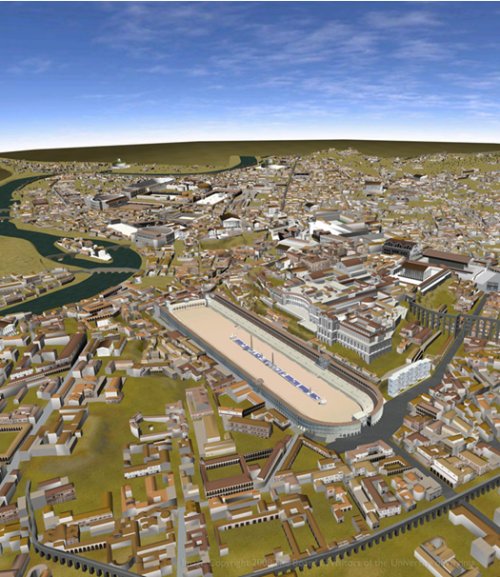
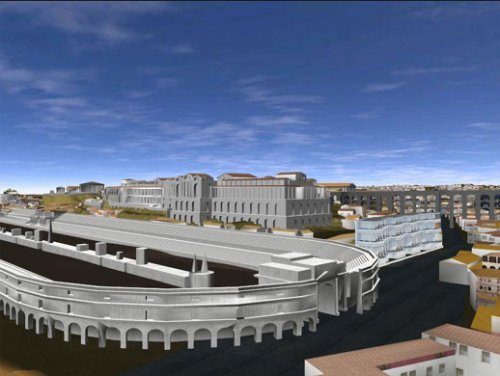
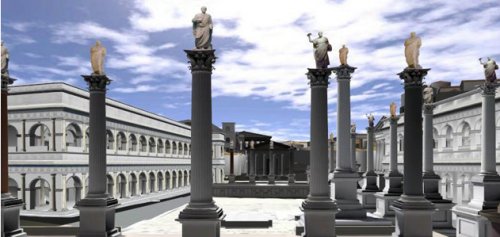
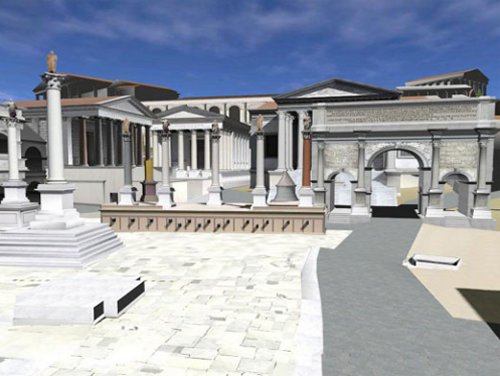
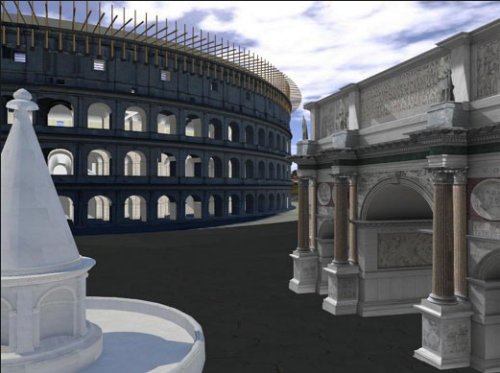
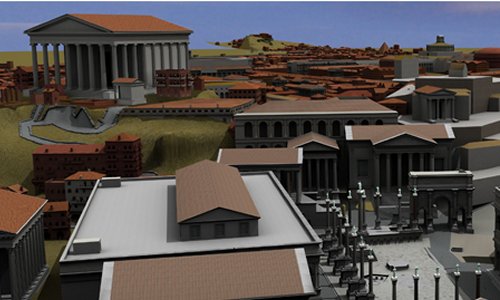
Thanks to Frischer
& his team, the
Temple of Jupiter
lives again
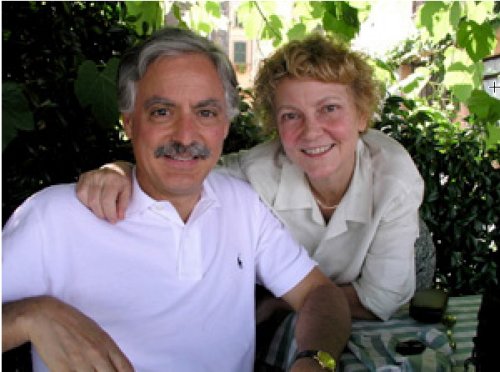
Bernard Frischer
and his lovely wife Jane Crawford
in a picture taken at Rome's Castel Sant Angelo |
| |
Discover
Rome Reborn
on Google
Earth
Rick Archer's Note: In
collaboration with the Rome Reborn project, Google Earth now
has a Rome 3D feature whenever you open the program.
Having temporarily run out of 21st century worlds to
conquer, Google is now travelling back in time.
In recent years, scientists, historians and archaeologists
around the world have embraced three-dimensional modeling of
cultural heritage sites. Information technology has
permitted them to recreate buildings and monuments that no
longer exist and to digitally restore sites that have been
damaged with the passage of time. The results can be used in
research to test new theories and in teaching to take
students on virtual tours of the historical sites.
Users of the search giant's Google Earth can now add a new
layer that lets them wander a 3D version of ancient Rome (or
at least they will be shortly. Google has just issued a
service advisory, titled "Rome wasn't built in a day",
announcing a delay of 24 hours or so before the new service
goes live).
The latest addition in Google's product release frenzy
graphically recreates Rome as it looked 1688 years ago under
Emperor Constantine. Users can take a virtual stroll around
6700 buildings, crafted in 3D in cooperation with the Rome
Reborn project - a virtual reality project that saw UCLA,
the University of Virginia, the Politecnico di Milano and
others create a 3D model of the city in 320AD.
"By several
orders of magnitude, 'Rome Reborn' is the most ambitious
such project ever undertaken," Bernard Frischer said. "The
'Rome Reborn' project is the continuation of five centuries
of research by scholars, architects and artists since the
Renaissance who have attempted to restore the ruins of the
ancient city with words, maps and images. Now, through hard
work by our interdisciplinary team, we have realized their
seemingly impossible dream.
"Making the models available in Google Earth is another step
in the creation of a virtual time machine which our children
and grandchildren will use to study the history of Rome and
many other great cities around the world."
Frischer added that the next challenge is to create an
online scholarly journal in which archaeologists can publish
the three-dimensional models of the sites they are studying.
"Such a journal will offer an incentive to more scholars to
create 3-D models of the great cities and sites in Egypt,
Greece, South America, Africa and Asia," he said. "Over
time, it will transform education and research. Tourists,
too, will be beneficiaries."
"Whether you are a student taking your first ancient history
class, a historian who spends your life researching ancient
civilizations, or just a history buff, access to this 3D
model in Google Earth will help everyone learn more about
Ancient Rome."
More info and a
download link are on
Google's Ancient
Rome 3D site.
|
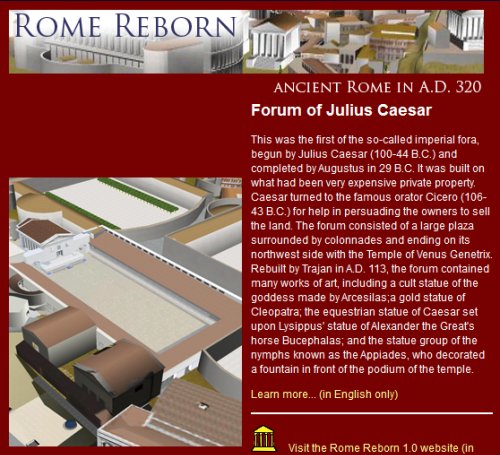
As you can see, thanks to Rome Reborn and Google Earth,
here is what
The Forum of Caesar
looked like
before Mussolini bulldozed the place down.
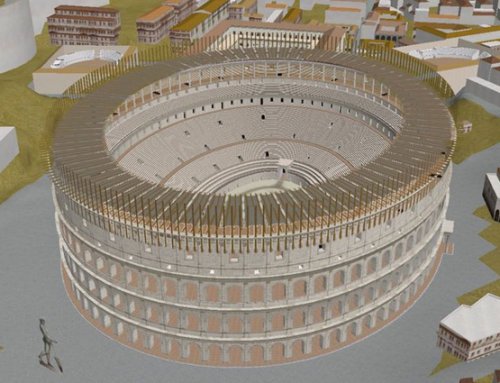 |
|